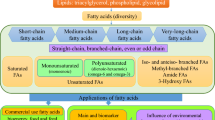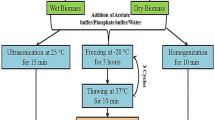Abstract
Dendrobium officinale is a perennial herb with medicinal and edible qualities. The growth and nutritional properties of this plant are significantly affected by the light quality. However, the impact of varying light quality on the phytochemical characteristics of tissue-cultured seedlings of D. officinale is still unknown. In this study, tissue-cultured seedlings of D. officinale were grown for ninety days under six LED lights, including white light (W), blue LED (B), red LED (R), and three composite light environments with varying quantities of red and blue light: 1:2 (R1B2), 1:1 (R1B1), and 2:1 (R2B1). The growth status and physiological signs of the seedlings were analyzed and we used high-performance liquid chromatography (HPLC), ultra-performance liquid chromatography/time-of-flight mass spectrometry (UPLC-Q/TOF-MS), and pathway enrichment analysis to thoroughly examine the metabolomic changes, with a focus on phenolic compounds. Our results indicated that R2B1 illumination led to the best growth of D. officinale seedlings, with maximal energy absorption, and phenolic contents. In conclusion, R2B1 was considered the most profitable for tissue-culture production of D. officinale.
Key message
The present study emphasizes that red-blue composite light significantly affects growth metrics, biomass production, and bioactive constituents of Dendrobium officinale tissue-cultured seedlings.




Similar content being viewed by others
Data availability
All data supporting the findings of this study are available within the paper and it’s Supplementary Information.
References
Alrifai O, Hao X, Marcone MF et al (2019) Current review of the Modulatory effects of LED lights on photosynthesis of secondary metabolites and future perspectives of Microgreen vegetables. J Agricultural Food Chem 67(22):6075–6090. https://doi.org/10.1021/acs.jafc.9b00819
Barcelo-Munoz A, Barcelo-Munoz M, Gago-Calderon A (2022) Effect of LED lighting on physical environment and microenvironment on in vitro plant growth and morphogenesis: the need to Standardize Lighting conditions and their description. Plants-Basel 11(1). https://doi.org/10.3390/plants11010060
Barros L, Duenas M, Dias MI et al (2013) Phenolic profiles of cultivated, in vitro cultured and commercial samples of Melissa officinalis L. infusions. Food Chem 136(1):1–8. https://doi.org/10.1016/j.foodchem.2012.07.107
Bartucca ML, Guiducci M, Falcinelli B et al (2020) Blue: red LED light proportion affects vegetative parameters, pigment content, and oxidative status of einkorn (Triticum monococcum L. ssp. Monococcum) wheatgrass. J Agric Food Chem 68(33):8757–8763. https://doi.org/10.1021/acs.jafc.0c03851
Bian ZH, Yang QC, Liu WK (2015) Effects of light quality on the accumulation of phytochemicals in vegetables produced in controlled environments: a review. J Sci Food Agric 95(5):869–877. https://doi.org/10.1002/jsfa.6789
Cao H, Ji Y, Li S et al (2019) Extensive metabolic profiles of leaves and stems from the Medicinal Plant Dendrobium officinale Kimura et Migo. Metabolites 9(10). https://doi.org/10.3390/metabo9100215
Chen X-l, Guo W-z, Xue X-z et al (2014) Growth and quality responses of ‘Green Oak Leaf’lettuce as affected by monochromic or mixed radiation provided by fluorescent lamp (FL) and light-emitting diode (LED). Sci Hort 172:168–175. https://doi.org/10.1016/j.scienta.2014.04.009
Chen L, Teng H, Xie Z et al (2018) Modifications of dietary flavonoids towards improved bioactivity: an update on structure-activity relationship. Crit Rev Food Sci Nutr 58(4):513–527. https://doi.org/10.1080/10408398.2016.1196334
Chen XD, Cai WJ, Xia J et al (2020) Metabolomic and transcriptomic analyses reveal that Blue Light promotes Chlorogenic Acid Synthesis in Strawberry. J Agric Food Chem 68(44):12485–12492. https://doi.org/10.1021/acs.jafc.0c05020
Daniels PN, Lee H, Splain RA et al (2022) A biosynthetic pathway to aromatic amines that uses glycyl-tRNA as nitrogen donor. Nat Chem 14(1):71–77. https://doi.org/10.1038/s41557-021-00802-2
Darko E, Hamow KA, Marcek T et al (2022) Modulated light dependence of growth, flowering, and the Accumulation of secondary metabolites in Chilli. Front Plant Sci 13. https://doi.org/10.3389/fpls.2022.801656
Dias MI, Sousa MJ, Alves RC et al (2016) Exploring plant tissue culture to improve the production of phenolic compounds: a review. Ind Crops Prod 82:9–22. https://doi.org/10.1016/j.indcrop.2015.12.016
Du S, Huang X, Cai Y et al (2021) Differential antioxidant compounds and activities in seedlings of two Rice cultivars under Chilling Treatment. Front Plant Sci 12. https://doi.org/10.3389/fpls.2021.631421
Fan XX, Zang J, Xu ZG et al (2013) Effects of different light quality on growth, chlorophyll concentration and chlorophyll biosynthesis precursors of non-heading Chinese cabbage (Brassica campestris L). Acta Physiol Plant 35(9):2721–2726. https://doi.org/10.1007/s11738-013-1304-z
Fazal H, Abbasi BH, Ahmad N et al (2016) Correlation of different spectral lights with biomass accumulation and production of antioxidant secondary metabolites in callus cultures of medicinally important Prunella vulgaris L. J Photochem Photobiology B-Biology 159:1–7. https://doi.org/10.1016/j.jphotobiol.2016.03.008
Fiutak G, Michalczyk M, Filipczak-Fiutak M et al (2019) The impact of LED lighting on the yield, morphological structure and some bioactive components in alfalfa (Medicago sativa L.) sprouts. Food Chem 285:53–58. https://doi.org/10.1016/j.foodchem.2019.01.086
Hashim M, Ahmad B, Drouet S, Plants-Basel et al (2021) 10(8). https://doi.org/10.3390/plants10081521
Hassanpour H (2022) Potential impact of red-blue LED light on callus growth, cell viability, and secondary metabolism of Hyoscyamus Reticulatus. Vitro Cell Dev Biology-Plant 58(2):256–265. https://doi.org/10.1007/s11627-021-10232-x
He J, Qin L, Chong EL, Choong TW, Lee SK (2017) Plant growth and photosynthetic characteristics of Mesembryanthemum crystallinum grown aeroponically under different blue- and red-LEDs. Front Plant Sci 8:361. https://doi.org/10.3389/fpls.2017.00361
Huang B, He W, Wu J et al (2021) Simultaneous determination of phenolic components in Dendrobium officinale stems, leaves and flowers by ultra-high performance liquid chromatography-tandem mass spectrometry. Shipin Kexue/Food Science 42(10):262–268. https://doi.org/10.7506/spkx1002-6630-20200529-363
Jia Y, Liu J, Xu M et al (2022) Light and Potassium improve the quality of Dendrobium officinale through optimizing Transcriptomic and Metabolomic Alteration. Molecules 27(15):4866. https://doi.org/10.3390/molecules27154866
Jin Q, Jiao C, Sun S et al (2016) Metabolic analysis of Medicinal Dendrobium officinale and Dendrobium huoshanense during different growth years. PLoS ONE 11(1). https://doi.org/10.1371/journal.pone.0146607
Karabegovic IT, Veljkovic VB, Lazic ML (2011) Ultrasound-assisted extraction of total phenols and flavonoids from Dry Tobacco (Nicotiana tabacum) leaves. Nat Prod Commun 6(12):1855–1856. https://doi.org/10.1177/1934578X110060121
Khan N, Bano A, Rahman MA et al (2019) UPLC-HRMS-based untargeted metabolic profiling reveals changes in chickpea (Cicer arietinum) metabolome following long-term drought stress. Plant Cell and Environment 42(1):115–132. https://doi.org/10.1111/pce.13195
Li Y, Xin G, Wei M et al (2017) Carbohydrate accumulation and sucrose metabolism responses in tomato seedling leaves when subjected to different light qualities. Sci Hort 225:490–497. https://doi.org/10.1016/j.scienta.2017.07.053
Lin K-H, Huang M-Y, Huang W-D et al (2013) The effects of red, blue, and white light-emitting diodes on the growth, development, and edible quality of hydroponically grown lettuce (Lactuca sativa L. var. capitata). Sci Hort 150:86–91. https://doi.org/10.1016/j.scienta.2012.10.002
Liu Y, Fang S, Yang W et al (2018) Light quality affects flavonoid production and related gene expression in Cyclocarya paliurus. J Photochem Photobiology B-Biology 179:66–73. https://doi.org/10.1016/j.jphotobiol.2018.01.002
Lobiuc A, Vasilache V, Pintilie O et al (2017) Blue and red LED illumination improves growth and bioactive compounds contents in Acyanic and Cyanic Ocimum basilicum L. Microgreens. Molecules 22(12). https://doi.org/10.3390/molecules22122111
Ng TB, Liu J, Wong JH et al (2012) Review of research on Dendrobium, a prized folk medicine. Appl Microbiol Biotechnol 93(5):1795–1803. https://doi.org/10.1007/s00253-011-3829-7
Ostersetzer-Biran O, Klipcan L (2020) Aminoacyl-tRNA synthetases and translational quality control in plant mitochondria. Mitochondrion 54:15–20. https://doi.org/10.1016/j.mito.2020.06.010
Phommalth S, Jeong Y-S, Kim Y-H et al (2008) Effects of Light Treatment on Isoflavone content of germinated soybean seeds. J Agric Food Chem 56(21):10123–10128. https://doi.org/10.1021/jf802118g
Shang WQ, Wang Z, Hou JN (2013) Effects of light emitting diode (LED) with different red/blue quality ratios on the growth of Dendrobium officinale plantlets in vitro. J Northwest AF Univ 41(05):155–159. https://doi.org/10.13207/j.cnki.jnwafu.2013.05.024
Si J, Yu Q, Song XS et al (2013) Artificial cultivation modes for Dendrobium officinale. China J Chin Materia Med 38(4):481–484. https://doi.org/10.4268/cjcmm20130403
Taulavuori K, Hyöky V, Oksanen J et al (2016) Species-specific differences in synthesis of flavonoids and phenolic acids under increasing periods of enhanced blue light. Environ Exp Bot 121:145–150. https://doi.org/10.1016/j.envexpbot.2015.04.002
Wang D, Wagner M, Butt H-J, Wu S (2015) Supramolecular hydrogels constructed by red-light-responsive host–guest interactions for photo-controlled protein release in deep tissue. Soft Matter 11(38):7656–7662. https://doi.org/10.1039/C5SM01888A
Wang S, Wang X, Shi X et al (2016) Red and blue lights significantly affect photosynthetic properties and Ultrastructure of Mesophyll cells in senescing grape leaves. Hortic Plant J 2(2):82–90. https://doi.org/10.1016/j.hpj.2016.03.001
Wojcikowski K, Gobe G (2014) Animal studies on Medicinal herbs: predictability, Dose Conversion and potential value. Phytother Res 28(1):22–27. https://doi.org/10.1002/ptr.4966
Wu M-C, Hou C-Y, Jiang C-M et al (2007) A novel approach of LED light radiation improves the antioxidant activity of pea seedlings. Food Chem 101(4):1753–1758. https://doi.org/10.1016/j.foodchem.2006.02.010
Wu D, Liu M, Yu W et al (2022) Red: blue LED light proportion affects biomass accumulation and polyamine metabolism in Anoectochilus Roxburghii studied by nano-electrospray ionization mass spectrometry. Ind Crops Prod 188:115636. https://doi.org/10.1016/j.indcrop.2022.115636
Ye S, Shao Q, Xu M et al (2017) Effects of light quality on morphology, enzyme activities, and bioactive compound contents in Anoectochilus Roxburghii. Front Plant Sci 8:857–863. https://doi.org/10.3389/fpls.2017.00857
Ying L (2012) Studies on tissue culture of Dendrobium officinale and accumulation changes of its secondary metabolites. Nanjing Forestry University]
Yuan Y, Zhang J, Liu X et al (2020) Tissue-specific transcriptome for Dendrobium officinale reveals genes involved in flavonoid biosynthesis. Genomics 112(2):1781–1794. https://doi.org/10.1016/j.ygeno.2019.10.010
Zhou J, Ding G, He J et al (2015) Effect of light quality on the growth of tissue culture chlorophyll and chlorophyll fluorescence in Anoectochilus Roxburghii. J Agric 5(05):67–72. https://doi.org/10.3969/j.issn.1000-2561.2016.09.017
Zhu H, Wang Y, Liu Y et al (2010) Analysis of flavonoids in Portulaca oleracea L. by UV-Vis spectrophotometry with comparative study on different extraction technologies. Food Anal Methods 3(2):90–97. https://doi.org/10.1007/s12161-009-9091-2
Funding
This work was supported by the project of Jiangxi Provincial Department of Science and Technology (20212AEI91010), and the National Natural Science Foundation of China (32360646).
Author information
Authors and Affiliations
Contributions
All authors contributed to the study conception and design. Material preparation, data collection and analysis were performed by Gaowei Zhang, Liping Luo and Yingbin Hao. The first draft of the manuscript was written by Kaili Tian, Fangjian Ning, Dong Wu, Qifang Sun, Wenjie Yu, Shengxiang Yi and all authors commented on previous versions of the manuscript. All authors read and approved the final manuscript.
Corresponding author
Ethics declarations
Competing interests
The authors declare that they have no competing interests.
Additional information
Communicated by Ming-Tsair Chan.
Publisher’s Note
Springer Nature remains neutral with regard to jurisdictional claims in published maps and institutional affiliations.
Electronic supplementary material
Below is the link to the electronic supplementary material.
Rights and permissions
Springer Nature or its licensor (e.g. a society or other partner) holds exclusive rights to this article under a publishing agreement with the author(s) or other rightsholder(s); author self-archiving of the accepted manuscript version of this article is solely governed by the terms of such publishing agreement and applicable law.
About this article
Cite this article
Zhang, G., Luo, L., Tian, K. et al. Metabolomics analysis of Dendrobium officinale tissue-cultured seedlings under red-blue composed light by using HPLC and UPLC-Q/TOF-MS. Plant Cell Tiss Organ Cult 156, 49 (2024). https://doi.org/10.1007/s11240-023-02678-1
Received:
Accepted:
Published:
DOI: https://doi.org/10.1007/s11240-023-02678-1




